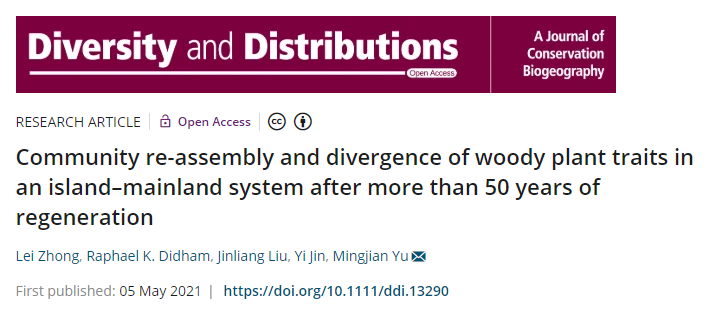
Title: Community re-assembly and divergence of woody plant traits in an island–mainland system after more than 50 years of regeneration
Lei Zhong, Raphael K. Didham, Jinliang Liu, Yi Jin, Mingjian Yu
First published: 05 May 2021
https://doi.org/10.1111/ddi.13290
Abstract
Aim
Understanding long-term community assembly trajectories following habitat fragmentation remains a major challenge. Varying time since disturbance and heterogeneous initial starting conditions confound real-world comparisons of re-assembly trajectories in fragmented versus intact systems. Here, we overcome these issues in a novel manner using a system of islands and adjacent mainland habitats with common initial starting conditions following clear-felling of forests during hydroelectric dam construction in 1959. Fifty years after resetting ‘future-islands’ and ‘future-mainland sites’ to common initial starting conditions, we determine the outcome of re-assembly trajectories in plant taxonomic, phylogenetic and functional trait composition, and how these have diverged between islands versus continuous mainland habitats.
Location
Thousand Island Lake, China.
Methods
We surveyed woody plant communities on 26 islands and 26 adjacent mainland plots, and characterized 12 functional traits for 91 woody plant species (>46,000 total stems with DBH ≥1 cm). We used variance partitioning analysis to discriminate major environmental and spatial drivers of compositional differences, and generalised linear models to test trait and phylogenetic responses to underlying environmental gradients in island versus mainland plots.
Results
We found striking differences in species composition between island and mainland plots. Variance partitioning showed that species composition on islands was governed by local environmental variables, suggesting an important role for environmental filtering, while compositional variation across mainland plots was determined by spatial variables. Ten of 12 functional traits showed significant divergence in community-weighted mean values between island and mainland plots. Moreover, most traits exhibited significant interaction effects between isolation (island versus mainland) and underlying environmental gradients in soil fertility and stress tolerance.
Main conclusion
These findings strongly suggest divergence in trait–environment relationships following isolation in fragmented habitats, with important implications for understanding future re-assembly trajectories in fragmented systems that now dominate the planet.
Link: https://onlinelibrary.wiley.com/doi/10.1111/ddi.13290





